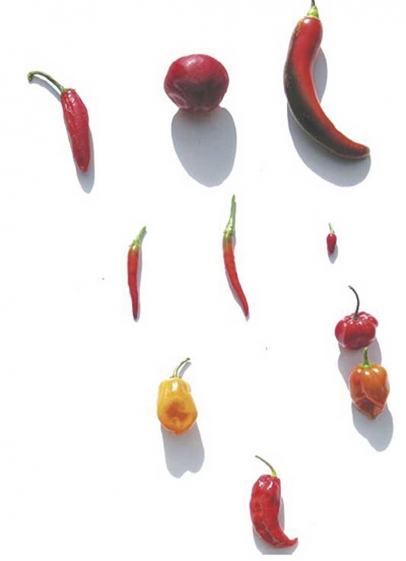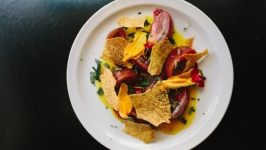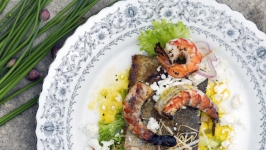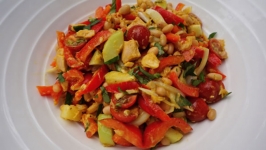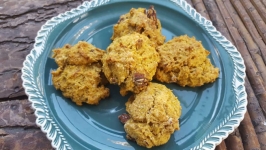The Heat is On: Hot Chili Peppers
The Queen of Cuisine (my wife) and I love hot chili peppers. We recently harvested the last of the chilies we grew over the summer, which included cherry peppers, Thai birds, Thai suns, Japanese Takanotsumes, long red chilies and serranos, yellow Scotch bonnets, orange and red habaneros, and the legendary ghost chili.
Hot pepper enthusiasts understand that the burning in our mouths does not mean that we are being harmed. In fact, the pain inherent in chili-eating is an important part of the consciousness-altering effects of very hot food. Our brains respond to the tongue-tingling sting with a significant release of endorphins, resulting in In-A-Gadda-Davida-quality alterations of consciousness.
Chilies are more than simple palate-fryers. They're full of enchanting sweet pepper fruit, citrus and bitter chili powder-like notes. This is not always true of prepared chili products that often contain added capsaicin oil; they're hotter than they should be with no redeeming character or interest and should be avoided whenever possible.
The hotness of a particular chili pepper was first quantified by the Scoville Organoleptic Test, a procedure developed in 1912 by Wilbur Scoville, a chemist employed by the Parke-Davis pharmaceutical corporation. Scoville ground up pure chilies, blended them with sugared water, and fed the resulting mixture to a panel of tasters. The tasters were presented with increasingly diluted concentrations of hot pepper until they could no longer feel the heat, and the dilution factor was noted as the Scoville Unit score (SCU) for the specific pepper being tested.
Today, capsaicin levels are determined by electrochemical techniques and high performance liquid chromatography, but the Scoville unit lives on in honour of Wilbur!
Our 2013 pepper crop spans the spectrum of chili heat. The cherry peppers have a nice bite at about 50 to 500 SCUs, not marked, but enough to make them perfect for pickling whole. The serrano and long red chilies score 8,000 to 22,000 SCUs, into authentically hot territory but not really scary. They're all-purpose peppers for use—fresh or dried—to modulate mid-range heat in various dishes.
We cultivated three Asian chilies this year. They'll get cooked into Asian dishes or will, more likely, be dried and flaked. Our Takanotsume peppers were hot (5,000 to 30,000 Scoville units), with an attractive lime note. The bird chili was comparably hot with a bitter chili-powder-like aroma. The Thai sun chili was a bit hotter, again with ripe fruit and that bitter chili character.
Now we move into the exciting and specialized world of super-hot chili peppers. First up, the Scotch bonnets, which were yellow this year. In perhaps the finest chicken wing hot sauce ever made this 90,000 to 325,000 SCU blast of white-hot heat and beautiful sweet pepper fruit is as tear-jerking as it is irresistible. Next, the red Caribbean habaneros, which came in red and orange. These babies score 120,000 to 400,000 SCUs and offer even more sweet fruit and bitter chili flavours. They'll make another stunning wing and rib sauce and will maybe sneak into chili con carne and curry.
Last but certainly not least come the (Naga) Bhut Jolokia, commonly known as the ghost chili. These plants grew like Topsy from the day we planted them. They flowered quickly and prolifically and producing rapidly ripening fruit. If this weren't enough, the said fruit is stunning. At over 1,000,000 Scoville units, our ghost chilies are scary hot. With intense chili bitterness and subtle bell pepper fruit, they're also scary good. The Queen of Cuisine crafted a triple-hot sauce out of them, which we pour on wings and chicken to beyond the point where our faces are wet with sweat, tears and other secretions. (This is also the point where those In-A-Gadda-Davida effects cut in.)
The current pepper literature suggests that ghost chilies are no longer the undisputed hot heavyweight champ. The Trinidad Moruga Scorpion chili has been rated at 1,200,000 to 2,009,231 and is reported to have great flavour. I'll let you know at the end of the 2014 growing season.
If any of this sounds more like fun than sheer lunacy to you, get yourself some pepper plants (many of ours came from local Chinese groceterias in the spring) or order seeds online. Choose your providers carefully; our last source sent seeds that wouldn't germinate and others that were mislabelled. A friend suggested that we start our "exotics" on a heating pad to emulate their tropical origins.


